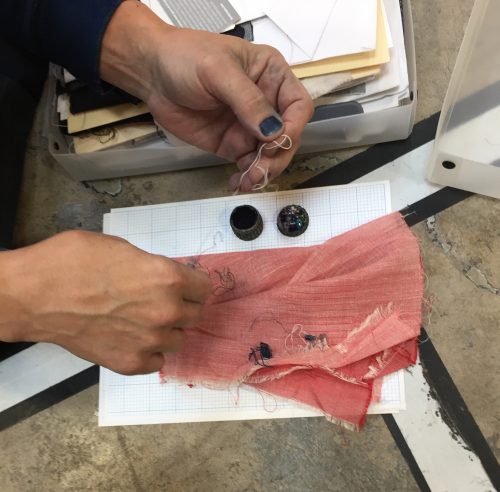 LS&Co. made history last fall when it launched the Levi’s® Commuter™ Trucker Jacket with Jacquard™ by Google, one of the first commercially sold wearable-technology garments.
LS&Co. made history last fall when it launched the Levi’s® Commuter™ Trucker Jacket with Jacquard™ by Google, one of the first commercially sold wearable-technology garments.
The launch was the culmination of a long-term project with Google that was incubated in our Eureka Innovation Lab. To capture the story of Jacquard, I visited Eureka in October to interview Bart Sights, vice president of technical innovation, who shared how the project evolved from a piece of red tattersall sewn with conductive thread into the stylish-yet-functional denim must-have for any commuter. The interview was conducted as part of our ongoing LS&Co. Oral History Project.
Bart described the challenges his team faced during those early days on the project when the folks from Google arrived for that first team meeting carrying a square of fabric. “One of their team members had just stitched that with a needle,” Bart said, pulling cloth out of a plastic box along with thin threads of copper. “Ivan [Poupyrev] had this hooked up to a computer screen and when he brushed it we could see it jump on the screen.”
It was Paul Dillinger, Head of Global Product Innovati on, who conceived of the idea of using a Levi’s® Commuter jacket as Levi’s® first wearable-technology garment. The project rapidly evolved from there. They envisioned cyclists using the jacket to listen to music, get directions or hear the time. “A Commuter Trucker jacket… is relatively difficult to make,” said Bart, “so we just made sleeves.” Through prototyping sleeves, the team settled on using copper threads in the left sleeve cuff—the conductive portion of the jacket.
on, who conceived of the idea of using a Levi’s® Commuter jacket as Levi’s® first wearable-technology garment. The project rapidly evolved from there. They envisioned cyclists using the jacket to listen to music, get directions or hear the time. “A Commuter Trucker jacket… is relatively difficult to make,” said Bart, “so we just made sleeves.” Through prototyping sleeves, the team settled on using copper threads in the left sleeve cuff—the conductive portion of the jacket.
Throughout the project, Bart carried the original tattersall, hand-drawn designs, bits of copper thread, and prototype sleeves in a plastic box that nearly disappeared when his car was stolen. That same box, and a Jacquard jacket are the latest additions to the LS&Co. Archives, documenting a fashion first.
Other highlights Bart shared included insights into early testing issues with the copper wiring because it was engaged every time the underside of the cuff came into contact with skin. When the prototypes were ready, San Francisco bike messengers tested them during their deliveries in the hilly city.
See a clip of Bart’s interview:
Want to keep up with the LS&Co. Archives and other cool LS&Co. heritage news? Follow Tracey on Twitter, @TraceyPanek, and stay tuned to Unzipped!







